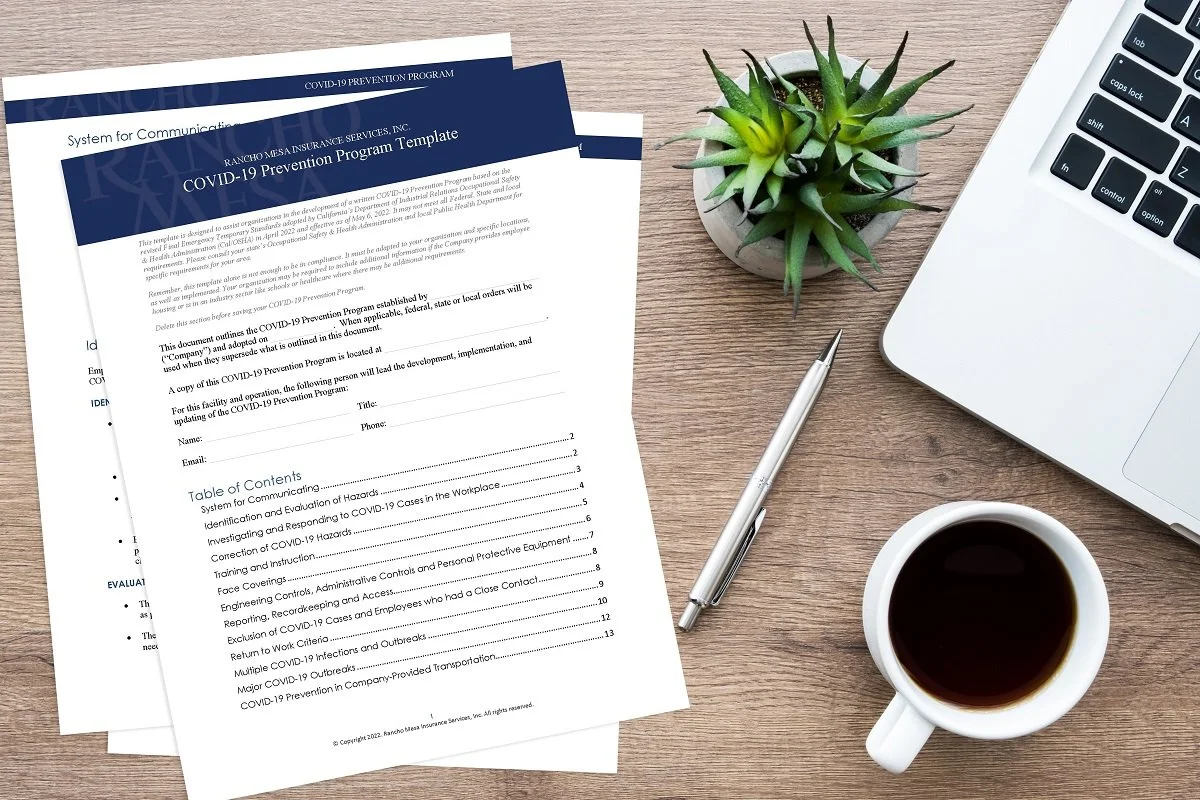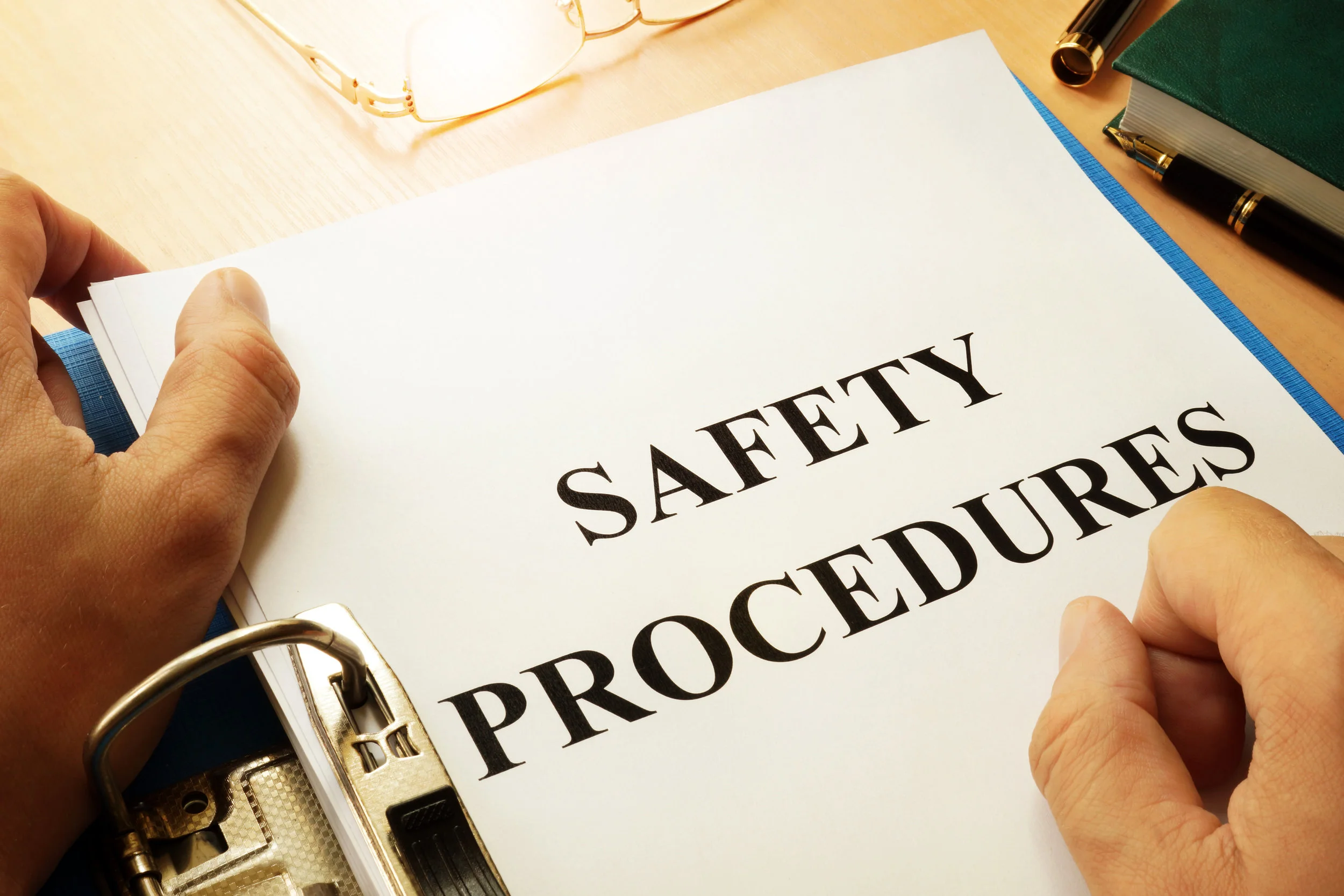
Industry News

Cal/OSHA Releases Final COVID-19 ETS
Author, Alyssa Burley, Media Communications and Client Services Manager, Rancho Mesa Insurance Services, Inc.
On Wednesday, April 6, 2022, Cal/OSHA released its third and final version of its COVID-19 Emergency Temporary Standard (ETS) that was approved by the Standards Board at its April 21, 2022 meeting. The revised standard is expected to remain in effect from May 6, 2022 through December 31, 2022.
Author, Alyssa Burley, Media Communications and Client Services Manager, Rancho Mesa Insurance Services, Inc.
On Wednesday, April 6, 2022, Cal/OSHA released its third and final version of its COVID-19 Emergency Temporary Standard (ETS) that was approved by the Standards Board at its April 21, 2022 meeting. The revised standard is expected to remain in effect from May 6, 2022 through December 31, 2022.
The third revision removes some language and requirements. Most notably:
Requirements of the ETS are the same for vaccinated and unvaccinated employees, and the definition for “fully vaccinated” has been removed.
California Department of Public Health's (CDPH) guidance governs exclusion and return-to-work criteria for those with a close contact, and when face coverings are required.
The “light test” for face coverings has been removed.
Self-administered and self-read testing is now acceptable to return to work when it includes independent verification like time-stamped photography.
A new definition for “returned case” has been added to identify those who have returned to work per the requirements in the ETS and did not develop COVID-19 symptoms.
Cleaning and disinfection procedures have been removed.
Requirements for physical distancing (except when there is a major outbreak) and barriers have been removed.
Cal/OSHA has revised several documents that may be helpful for employers:
What Employers and Workers Need to Know About COVID-19 Isolation and Quarantine
Revisions to the COVID-19 Prevention Emergency Temporary Standards
Rancho Mesa has revised its COVID-19 Prevention Program template based on the April 6, 2022 proposed revised ETS language. Download a copy of the template from within the Risk Management Center, or from the link below.
Manage Your COVID-19 Risk With These Tools
Author, Alyssa Burley, Media Communications and Client Services Manager, Rancho Mesa Insurance Services, Inc.
While most of the country is under shelter-in-place orders, many of our clients work in essential industries that must continue to provide vital services to the community. Therefore, it is imperative that they have the tools they need to keep their employees safe.
Author, Alyssa Burley, Media Communications and Client Services Manager, Rancho Mesa Insurance Services, Inc.
While most of the country is under shelter-in-place orders, many of our clients work in essential industries that must continue to provide vital services to the community. Therefore, it is imperative that they have the tools they need to keep their employees safe.
For those who must continue to operate, we’ve complied resources employers can use to implement COVID-19-specific written safety programs, provide employee training, and signage that can be posted in the workplace. Many of these resources are available in both English and Spanish.
Our goal is to provide the tools our clients’ needs to protect their employees.
Program Administration
Our risk management and safety partners have developed templates that employers can use, today.
COVID-19 Guide (English/Spanish)
This document should be reviewed by ownership and management for clarification on how to implement the COVID-19 Written Program.COVID-19 Guide Amendment A: Employee Has Tested Positive for COVID-19, Now What?
Amendment A provides instructions on what to do if your employee tests positive for the COVID-19 virus.
COVID-19 Health Screening Form (English/Spanish)
Each employee, should complete this form daily before performing any work. Foremen and supervisors should send these completed forms to management for record keeping purposes.COVID-19 Written Program (English/Spanish)
This program should be reviewed by all employees including ownership, management and workers in the field.COVID-19 Written Program Acknowledgement Form (English/Spanish)
All staff members must acknowledge they have read and understand the new program by signing the acknowledgement form.COVID-19 Checklist for Management (English/Spanish)
This checklist should be used daily for management to evaluate safety within the office for employees and identify any areas of concern.COVID-19 Checklist for Jobsites (English/Spanish)
This checklist should be used daily by foreman to evaluate the safety within the jobsite for employees and identify any areas of concern.COVID-19 Site-Specific Safety Plan
This site-specific safety plan may be required by a general contractor or site owner. It is a template employers can use to develop COVID-19 safety plans for specific jobsites where employees are working.
Training Staff
We have complied training that teach staff how to prevent the spread of the COVID-19 virus in the workplace through proper hygiene.
COVID-19 How to Prevent Catching & Spreading Coronavirus (English/Spanish)
Coronavirus and Workplace Hygiene (English/Spanish)
Safety Signage
In addition to proper training, signage is another way to remind employees of proper ways to prevent the spread of the COVID-19 virus within the workplace and among their co-workers.
CDC – Don’t’ Spread Germs at Work (English/Spanish)
CDC – Handwashing Sign (English/Spanish)
CDC – Handwashing: A Corporate Activity
COVID-19 – Do Not Enter If You Have Symptoms
COVID-19 – Eliminate the Spread Workday Flowchart
COVID-19 – How in infects and Spreads
COVID-19 – Prevention Practices – Why is soap better?
COVID-19 – Wash Hands Upon Entry Sign
To access these resources, login to the Risk Management Center and type in “COVID-19” or “Coronavirus” into the search box. If you already have an account but do not remember your login information, click the “Forgot Username or Password” link on the login screen.
We’ll continue to provide COVID-19 resources as they become available. Please visit www.ranchomesa.com/covid-19 for human resources content, insurance carrier statements and more.
Senate Bill 778 Extends Employee Anti-Harassment Training Deadline
Author, Alyssa Burley, Media Communications and Client Services Manager, Rancho Mesa Insurance Services, Inc.
Newly passed Senate Bill 778 (SB 778) extends the deadline set in Senate Bill 1343 for California’s mandatory Anti-Harassment Training from January 1, 2020 to January 1, 2021. The bill also addresses concerns about supervisory employees and clarifies when temporary workers must be trained. California Governor Newsom signed the bill into law on August 30, 2019, which included an urgency clause that allows the bill to go into effect immediately.
Author, Alyssa Burley, Media Communications and Client Services Manager, Rancho Mesa Insurance Services, Inc.
Newly passed Senate Bill 778 (SB 778) extends the deadline set in Senate Bill 1343 for California’s mandatory Anti-Harassment Training from January 1, 2020 to January 1, 2021. The bill also addresses concerns about supervisory employees and clarifies when temporary workers must be trained. California Governor Newsom signed the bill into law on August 30, 2019, which included an urgency clause that allows the bill to go into effect immediately.
What SB 778 Means to CA Employers
The changes made by SB 778 not only extends the deadline for non-supervisory employee Anti-Harassment training, but also allows supervisory employees to stay on their existing two-year training schedule. For example, if a supervisory employee completed Anti-Harassment training in 2018, their next training, with the SB 1343 compliant content, will be due in 2020 - two years from their last training date, which is before the new deadline. Likewise, if a supervisory employee was trained in 2019, their next training due date will be in 2021.
Non-supervisory employees will need to complete their initial 1-hour Anti-Harassment training by January 1, 2021. For those who have already taken the training in 2019, we recommend they maintain their two-year schedule, and complete the training again in 2021.
Both supervisory and non-supervisory employees must be trained within six months of hire. However, temporary or seasonal workers who are hired for less than six months must be trained within 30 days of hire.
For questions about this training requirement or to learn how to enroll your supervisors and employees, register for the “How to Enroll Supervisors and Employees in the Online Anti-Harassment Training” webinar or contact Rancho Mesa’s Client Services Department at (619) 438-6869.
Employers Prepare As Reports of Sexual Harassment Spike
Author, Alyssa Burley, Media Communications and Client Services Manager, Rancho Mesa Insurance Services, Inc.
Americans are all too familiar with the #MeToo movement that has shed light on sexual harassment in the workplace. Outspoken celebrities and prominent public figures have brought this topic to the forefront in the media. With all the publicity surrounding sexual harassment allegations, people are empowered to speak out and report unwanted behaviors in the workplace. This leaves many employers asking what they can do to prevent harassment and prepare for possible harassment allegations.
Editor’s Note: This article was originally published on June 27, 2019 and has been updated for accuracy on September 12, 2019.
Author, Alyssa Burley, Media Communications and Client Services Manager, Rancho Mesa Insurance Services, Inc.
Americans are all too familiar with the #MeToo movement that has shed light on sexual harassment in the workplace. Outspoken celebrities and prominent public figures have brought this topic to the forefront in the media. With all the publicity surrounding sexual harassment allegations, people are empowered to speak out and report unwanted behaviors in the workplace. This leaves many employers asking what they can do to prevent harassment and prepare for possible harassment allegations.
Charges Alleging Sexual Harassment FY 2010 - FY 2018
- Reports
- Reports
The United States Equal Employment Opportunity Commission (EEOC) released its “Charges Alleging Sexual Harassment FY 2010 - FY 2018” report. The data shows from 2010 to 2017 reports of alleged sexual harassment incidents actually declined 15.7%, over the seven-year span. However, based on the data, it is difficult to know if incidents of sexual harassment declined or just the reporting of incidents declined.
However, during 2018 there was an increase of 13.6% in alleged sexual harassment incidents, which accounted for over 7,600 claims at a cost of $56.6 million dollars in damages.
| Year | 2010 | 2011 | 2012 | 2013 | 2014 | 2015 | 2016 | 2017 | 2018 |
|---|---|---|---|---|---|---|---|---|---|
| Percentage Change Over Previous Year Number of Charges |
NA 7,944 |
-1.4% 7,809 |
-3% 7,571 |
-4.2% 7,256 |
-5.7% 6,862 |
-0.6% 6,822 |
-0.9% 6,758 |
-0.9% 6,696 |
13.6% 7,609 |
| Percentage Change Over Previous Year Damages (In Millions) |
NA $41.2 |
9.5% $45.1 |
-4.7% $43 |
3.7% $44.6 |
-21.5% $35 |
31.4% $46 |
-11.5% $40.7 |
13.8% $46.3 |
22.2% $56.6 |
EEOC. Charges Alleging Sexual Harassment FY 2010 - FY 2018. https://www.eeoc.gov/eeoc/statistics/enforcement/sexual_harassment_new.cfm.
California’s Senate Bill 1343 (SB 1343) now requires employers with 5 or more employees to provide 2-hour Anti-Harassment training to supervisors and 1-hour training to employees, every two years. As part of this new requirement, the initial training must be completed for all employees and supervisors by January 1, 2021, according to Senate Bill 778, approved on August 30, 2019, which extends the training due date. The changes made by SB 778 not only extends the due date to January 1, 2021, but also addresses concerns about supervisory employees and clarifies when temporary workers must be trained. Read about the changes here.
It’s our belief that as more people are trained to recognize harassment in its many forms, we expect to see the number of reported alleged harassment incidents increase in the coming years. So, what should California employers do to mitigate this increased risk?
Course of Action
For employers, the best course of action is two-fold. Make sure you are compliant by training your employees and supervisors; second, make sure you have Employment Practices Liability Insurance (EPLI) as part of your risk management portfolio.
Training Supervisors and Employees
Understanding the confusion, time and financial burden SB 1343 puts on all California employers, Rancho Mesa offers its clients SB 1343-compliant free online supervisor and employee Anti-Harassment training. Supervisor and employee trainings can be completed 100% online via a computer, tablet or mobile device.
California employers who are not clients of Rancho Mesa can find this training through 3rd party vendors that work in the Human Resource arena and will need to contract with them directly to meet this requirement.
Employment Practices Liability Insurance (EPLI)
EPLI is “a type of liability insurance covering wrongful acts arising from the employment process. The most frequent types of claims covered under such policies include: wrongful termination, discrimination, sexual harassment, and retaliation,” according to the International Risk Management Institute, Inc.
If your organization currently does not have EPLI, or you are unsure about what is covered in your policy, we recommend you contact your insurance broker or call us to get clarification. With the projected increase in these types of claims, not having this vital coverage in place could expose your company to severe negative financial impacts.
Whether the increase in reported alleged sexual harassment incidents is a result of more incidents or simply more people feeling comfortable reporting the harassment, every employer should be prepared to properly train their employees and supervisors, while actively working to prevent and stop all forms of harassment in the workplace.
Contact the Rancho Mesa Insurance Services Client Services Department at (619) 438-6869 or aburley@ranchomesa.com for more information about free anti-harassment training for supervisors and employees, or learn more through our other articles on the topic.
Alyssa Burley is NOT a licensed insurance professional. Informational statements regarding insurance coverage are for general description purposes only. Contact a licensed insurance professional for specific questions.
4 Essential Tools For Managing Your Company's Risk
Author, Alyssa Burley, Client Services Coordinator, Rancho Mesa Insurance Services, Inc.
Risk Management is the identification, analysis, assessment, control, and avoidance, minimization, or elimination of unacceptable risks. Companies manage their risk through what is known as an Injury and Illness Prevention Program (IIPP). As a business owner, supervisor or manager, there are tools available to assist in risk management endeavors.
Author, Alyssa Burley, Client Services Coordinator, Rancho Mesa Insurance Services, Inc.
Risk Management is the identification, analysis, assessment, control, and avoidance, minimization, or elimination of unacceptable risks. Companies manage their risk through what is known as an Injury and Illness Prevention Program (IIPP). As a business owner, supervisor or manager, there are tools available to assist in risk management endeavors.
“Injury and illness prevention programs are systems that can substantially reduce the number and severity of workplace injuries and illnesses while reducing costs to employers,” according to OSHA.
Below are four tools your company can use to proactively manage the IIPP.
Training
Access to a robust bilingual database of both online and offline trainings is essential to ensuring employees are up to date on required and supplemental training. Weekly training shorts (e.g., tailgate topics, safety shorts) that are industry specific and relevant keeps employees focused on safety and reinforces a safety culture within the company.
“Training in the safe way for workers to do their jobs well is an investment that will pay back over and over again in fewer injuries and illnesses, better morale, lower insurance premiums and more,” according to OSHA’s training requirements document.
Tracking of Employee Training
Maintaining employee training documentation is vital for ensuring employees are trained on required topics and in regular intervals. Having an electronic tracking system can streamline the process and allow management to generate reports and search records from any device with internet access.
According to OSHA’s documentation, “it is a good idea to keep a record of all safety and health training. Documentation can also supply an answer to one of the first questions an incident investigator will ask: ‘Did the employee receive adequate training to do the job?’”
To learn more about OSHA training requirements, review Training Requirements in OSHA Standards.
Incident Tracking and OSHA Reporting
Documenting near-misses, injuries, and accidents can keep your company OSHA compliant while helping to prevent incidents in the future. Making sure supervisors complete a thorough investigation and collect witness statements at the time of the incident can also ensure hazards are addressed immediately. Electronic documentation of a near-miss or incident creates a standardization of data that is collected, allows for trend reporting, and electronic submission of OSHA 300A Summary data.
Written Job Hazard Analysis
A job hazard analysis (JHA) identifies the dangers of specific tasks in order to reduce the risk of injury to workers. JHAs are important for managing risk because they help to identify hazards which can be reduced or eliminated before an employee is hurt. Once a JHA is established, management should observe and document their findings and any remedies that are made.
Risk Management starts with a written IIPP, but it is up to management to implement and utilize the available tools to make it effective. Contact Rancho Mesa’s Client Services Department at (619) 438-6869 to learn more about the Risk Management Center platform.





